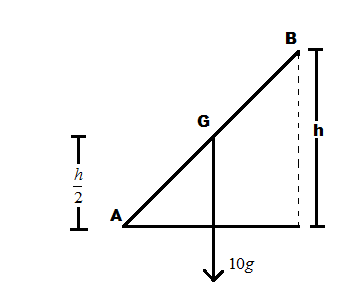
A rod AB of mass \[10Kg\] and length \[4m\] rests on a horizontal floor with end A fixed so, as to rotate it in a vertical plane about a perpendicular axis passing through A. If the work done on the rod is \[100J\], the height to which the end B be raised vertically above the floor is?
Answer
221.4k+ views
Hint:Before proceeding with the question first we need to know how the work has been applied to a rod. Assuming a rod which has been lifted up and one of its ends is in contact with the ground and the other is the uniform end. In a conservative field of force, work is path independent.
Formula used:
Expression of Work done is,
\[W = F \times d\]
Where, Work done on the rod is given as \[100J\]. F is the force applied on the rod and d is the displacement done by the rod.
Complete step by step solution:
Considering the figure below,

Here, as we know, the value for the work done on the rod is given as \[100J\].
We know the formula,
\[F = mg\]
Where, \[m\] is mass and \[g\] is the acceleration due to gravity.
Hence we can write work done,
\[W = F \times d\\
\Rightarrow W = \left( {mg} \right) \times d\]
Here, displacement is equal to \[\dfrac{h}{2}\]
Therefore, we can write
\[\begin{array}{l}W = \left( {mg} \right) \times d\\ \Rightarrow W = \left( {mg} \right) \times \dfrac{h}{2}\\\Rightarrow 100 = \dfrac{{10 \times 10 \times h}}{2}\end{array}\]
On solving this, we get
\[h = 2m\]
Hence, the height to which the end B be raised vertically above the floor is \[2m\] respectively.
Note: As we know, work is path independent, and assuming a rod which has been lifted up and one of its ends is in contact with the ground and the other is the uniform end we calculated the required height to which the end B be raised vertically above the floor.
Formula used:
Expression of Work done is,
\[W = F \times d\]
Where, Work done on the rod is given as \[100J\]. F is the force applied on the rod and d is the displacement done by the rod.
Complete step by step solution:
Considering the figure below,

Here, as we know, the value for the work done on the rod is given as \[100J\].
We know the formula,
\[F = mg\]
Where, \[m\] is mass and \[g\] is the acceleration due to gravity.
Hence we can write work done,
\[W = F \times d\\
\Rightarrow W = \left( {mg} \right) \times d\]
Here, displacement is equal to \[\dfrac{h}{2}\]
Therefore, we can write
\[\begin{array}{l}W = \left( {mg} \right) \times d\\ \Rightarrow W = \left( {mg} \right) \times \dfrac{h}{2}\\\Rightarrow 100 = \dfrac{{10 \times 10 \times h}}{2}\end{array}\]
On solving this, we get
\[h = 2m\]
Hence, the height to which the end B be raised vertically above the floor is \[2m\] respectively.
Note: As we know, work is path independent, and assuming a rod which has been lifted up and one of its ends is in contact with the ground and the other is the uniform end we calculated the required height to which the end B be raised vertically above the floor.
Recently Updated Pages
States of Matter Chapter For JEE Main Chemistry

Mass vs Weight: Key Differences Explained for Students

Circuit Switching vs Packet Switching: Key Differences Explained

Conduction Explained: Definition, Examples & Science for Students

Balancing of Redox Reactions - Important Concepts and Tips for JEE

Atomic Size - Important Concepts and Tips for JEE

Trending doubts
JEE Main 2026: Application Form Open, Exam Dates, Syllabus, Eligibility & Question Papers

Derivation of Equation of Trajectory Explained for Students

Hybridisation in Chemistry – Concept, Types & Applications

Understanding the Angle of Deviation in a Prism

How to Convert a Galvanometer into an Ammeter or Voltmeter

Degree of Dissociation: Meaning, Formula, Calculation & Uses

Other Pages
JEE Advanced Marks vs Ranks 2025: Understanding Category-wise Qualifying Marks and Previous Year Cut-offs

Thermodynamics Class 11 Physics Chapter 11 CBSE Notes - 2025-26

Units And Measurements Class 11 Physics Chapter 1 CBSE Notes - 2025-26

NCERT Solutions For Class 11 Physics Chapter 8 Mechanical Properties Of Solids

Motion in a Straight Line Class 11 Physics Chapter 2 CBSE Notes - 2025-26

Laws of Motion Class 11 Physics Chapter 4 CBSE Notes - 2025-26




